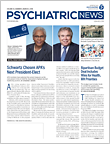Merriam-Webster’s Dictionary defines stigma as both “a mark of shame or discredit” and “an identifying mark or characteristic; a specific diagnostic sign of a disease.” Most psychiatric disorders unofficially meet both definitions. Although there is nothing inherently shameful about having major depression, schizophrenia, or PTSD, it is an unfortunate fact that our society stigmatizes these and other mental illnesses. As the treaters of these disorders, are we doing enough to address stigma?
How many of us faced the question from family members when we announced we planned to become psychiatrists, “Why don’t you want to be a real doctor?” The profession of psychiatry is stigmatized within medicine, but it is our patients who suffer far more from this stigma. Our patients are often misunderstood and marginalized, portrayed as irrational and/or dangerous by bullies and the media. They learn to stay silent about their suffering, cut off from treatment and support by the shame they and others attach to their symptoms.
I think of stigma as a giant canyon, with the patient on one side, treatment and support on the other. The depth and breadth of the canyon may vary, depending on the patient’s particular family, culture, and previous experience with treatment. Patients can climb the long and arduous trail across the canyon or we can find ways to assist with the crossing.
At a folk music concert in late 2017, singer-songwriter Carla Sciaky introduced her song “Awakening” by saying: “I wrote this song 26 years ago, after several years of working my way up out of a deep depression. Once written, I performed it all across the country, at every single solo concert I gave, for years, but I was never brave enough to use the word ‘depression’ in my introduction to the song. Now, fast forward, I know that we need to bring topics like depression and mental illness out into the open. There is a stigma attached to depression, but now I know there is no shame—nothing to be ashamed of. For anyone who has been on any side of either one, we are not alone—we are never alone!”
Carla’s courageous introduction drew enthusiastic applause and cheers from the audience, who I believe was thrilled by her naming the beast out loud, in public. I hope Carla’s example will encourage others from the audience to speak up in their own venues, whether within the family, at a social gathering, at the workplace, or at public events.
Psychiatrists cheer when authors, artists, musicians, and other celebrities publicly share their stories. We recommend their books and songs to our patients because we recognize the power of another’s story to normalize one’s experience. These shared stories form a bridge across the canyon of stigma, encouraging patients to access treatment and support with more ease.
Should psychiatrists merely rely on others to build these narrative bridges? How much more powerful would it be, both for patients and for the house of medicine, if psychiatrists came forward with our own stories about overcoming mood and anxiety disorders?
By relying on nonpsychiatrists’ stories, we maintain the us/them duality of treatment: we are the healers and they are the patients. We know from the 2003 National Comorbidity Survey that 46 percent of Americans reported meeting criteria for a DSM-IV disorder at some time in their life. It is likely that a proportionate number of doctors have contended with a mood, anxiety, or substance use disorder.
We also know that the prevalence of depression or depressive symptoms among resident physicians is increasing. In its December 8, 2015, issue, JAMA published a meta-analysis of studies of the mental health of residents between 1963 and 2015 that found that the rate of depression ranged from 20.9 percent to 43.2 percent depending on the instrument used, and increasing with calendar year. This exceeds the rate of depression in the general population. It is neither credible nor helpful to think of psychiatric disorders as happening to them, to patients who are somehow not like us.
Although the social status of physicians is not the same now as it was in the 1950s, we still enjoy a certain prestige and likely receive more respect than celebrities. By sharing our own stories of mental illness and the power of treatment, we can build especially strong bridges across the canyon of stigma to reach other patients like ourselves, to send the message: we are just like you. We can help you because, collectively, we have crossed this canyon, too. ■
“Prevalence of Depression and Depressive Symptoms Among Resident Physicians: A Systematic Review and Meta-analysis” can be accessed
here.

